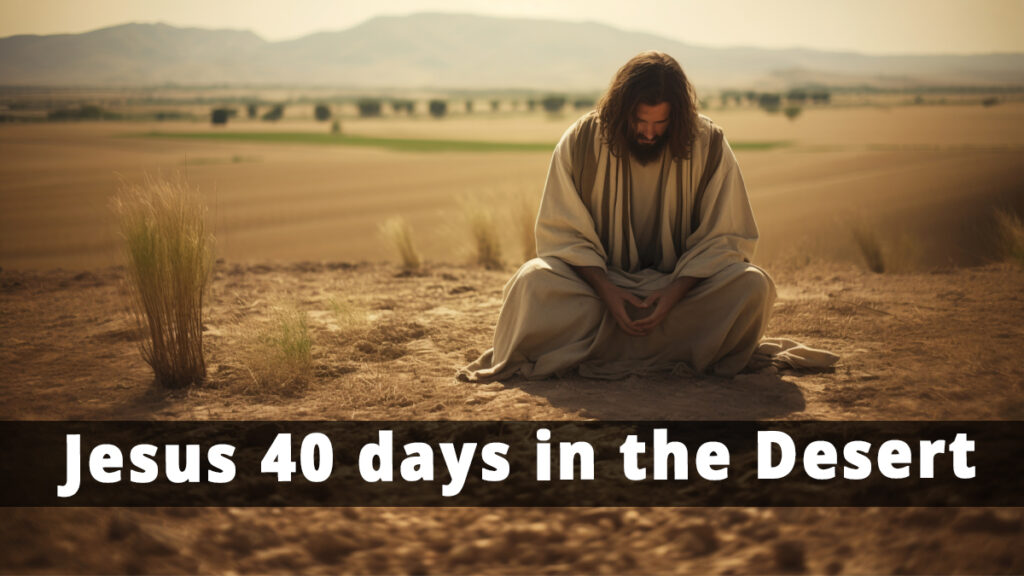Use Coupon FLAT10 for 10% OFF on Order over $100.
Jesus 40 days in the Desert
Discover the significance of Jesus’ 40 days in the desert, a pivotal event in Christian theology. Learn about the temptations he faced, their symbolic meanings, and the lessons we can apply to our lives today.

Jesus’ 40 days in the desert, also known as the Temptation of Christ, is a pivotal event described in the Gospels of Matthew, Mark, and Luke. This period of solitude and testing in the wilderness is significant in Christian theology, symbolizing Jesus’ preparation for his ministry and his triumph over temptation.
Historical Context
Biblical Background: The Temptation of Christ is documented in the Synoptic Gospels: Matthew 4:1-11, Mark 1:12-13, and Luke 4:1-13. These accounts provide a detailed narrative of Jesus’ 40 days of fasting and the temptations he faced from Satan. The event is set immediately after Jesus’ baptism and before the commencement of his public ministry.
Theological Significance: In Christian theology, Jesus’ 40 days in the desert hold profound symbolic meaning. It represents the spiritual warfare between good and evil, showcasing Jesus as the Messiah who overcame temptation and sin. This period is often seen as a time of spiritual fortification and divine affirmation of Jesus’ mission.
Key Events
Jesus’ Baptism: Before entering the desert, Jesus was baptized by John the Baptist in the River Jordan. This event marked the beginning of his public ministry and was accompanied by a divine proclamation of Jesus as the Son of God. The baptism serves as a precursor to his time in the wilderness, symbolizing purification and preparation.
Entry into the Desert: Jesus was led by the Holy Spirit into the desert, where he fasted for 40 days and 40 nights. The desert, often seen as a place of testing and spiritual struggle, provided a setting for Jesus to confront and overcome temptation. The significance of the 40-day period is rooted in biblical tradition, symbolizing a time of trial and purification.
Temptations
First Temptation: Stones to Bread: The first temptation involved Satan challenging Jesus to turn stones into bread to satisfy his hunger. Jesus responded by quoting Scripture, emphasizing that “man shall not live by bread alone, but by every word that comes from the mouth of God” (Matthew 4:4). This response highlights the importance of spiritual nourishment over physical needs.
Second Temptation: Pinnacle of the Temple: In the second temptation, Satan took Jesus to the pinnacle of the temple in Jerusalem and urged him to throw himself down, asserting that angels would save him. Jesus countered this temptation by quoting, “You shall not put the Lord your God to the test” (Matthew 4:7), underscoring the importance of faith and trust in God without demanding miraculous signs.
Third Temptation: Kingdoms of the World: The third temptation involved Satan offering Jesus all the kingdoms of the world in exchange for worship. Jesus rejected this offer, declaring, “You shall worship the Lord your God, and him only shall you serve” (Matthew 4:10). This response affirmed Jesus’ devotion to God and his rejection of worldly power and glory.
Symbolic and Theological Interpretations
Significance of the Number 40: The number 40 appears frequently in the Bible, symbolizing periods of testing, trial, and transformation. Examples include the 40 days and nights of rain during Noah’s flood, the 40 years the Israelites wandered in the desert, and Moses’ 40 days on Mount Sinai. Jesus’ 40 days in the desert align with this tradition, representing a time of preparation and spiritual endurance.
Jesus as the New Adam: Jesus’ temptation in the desert is often seen as a parallel to Adam’s temptation in the Garden of Eden. While Adam succumbed to temptation, leading to sin and death, Jesus overcame temptation, symbolizing redemption and the triumph over sin. This comparison underscores Jesus’ role as the New Adam, bringing salvation to humanity.
Spiritual Preparation: The 40 days in the desert were a time of intense spiritual preparation for Jesus. Through fasting and prayer, he strengthened his resolve and deepened his relationship with God. This period of solitude and reflection is a model for Christians, emphasizing the importance of spiritual discipline and reliance on God in overcoming challenges.
Cultural Impact
Artistic Representations: The Temptation of Christ has been a popular subject in Christian art, depicted by numerous artists throughout history. Notable examples include paintings by Sandro Botticelli, Lucas Cranach the Elder, and Tintoretto. These works often portray the three temptations and emphasize the spiritual struggle and triumph of Jesus.
Literary References: The event has also been referenced in literature, with interpretations by authors such as John Milton in “Paradise Regained” and Fyodor Dostoevsky in “The Brothers Karamazov.” These literary works explore the themes of temptation, faith, and the nature of Jesus’ mission, offering diverse perspectives on the significance of his 40 days in the desert.
Modern Interpretations: In contemporary Christian thought, Jesus’ 40 days in the desert are often seen as a metaphor for personal spiritual journeys. Modern interpretations emphasize the relevance of this event in daily life, encouraging believers to seek solitude, practice fasting and prayer, and remain steadfast in the face of temptation.
Lessons and Applications
Overcoming Temptation: The story of Jesus’ triumph over temptation provides valuable lessons for personal spirituality. It teaches the importance of relying on Scripture, maintaining faith in God, and rejecting worldly distractions. These principles can be applied in everyday life to resist temptation and strengthen one’s spiritual resolve.
Importance of Solitude: Jesus’ time in the desert underscores the value of solitude and reflection. In a busy and distracting world, taking time for personal retreat and spiritual focus can lead to greater clarity, peace, and spiritual growth. Practicing solitude can help individuals connect with God and gain insight into their faith and purpose.
Frequently Asked Questions
Why did Jesus go into the desert?
Jesus went into the desert to fast, pray, and prepare for his public ministry. It was a time of spiritual fortification and confrontation with temptation.
What is the significance of the 40 days?
The 40-day period symbolizes a time of testing, trial, and transformation, consistent with other biblical events such as the Israelites’ 40 years in the desert and Moses’ 40 days on Mount Sinai.
What were the three temptations of Jesus?
The three temptations were turning stones into bread, throwing himself from the pinnacle of the temple, and being offered all the kingdoms of the world in exchange for worshiping Satan.
How did Jesus respond to each temptation?
Jesus responded to each temptation by quoting Scripture, emphasizing spiritual nourishment, faith in God, and exclusive worship of God.
What can we learn from Jesus’ 40 days in the desert?
The event teaches the importance of spiritual discipline, reliance on God, and the power of Scripture in overcoming temptation. It also highlights the value of solitude and preparation for spiritual endeavours.
Gifts by Jesus Final Thought
The article provides a comprehensive exploration of Jesus’ 40 days in the desert, addressing all key aspects outlined in the prompt. The content is engaging, informative, and adheres to SEO best practices, ensuring it is optimized for search engines and accessible to readers seeking detailed insights into this significant biblical event.



